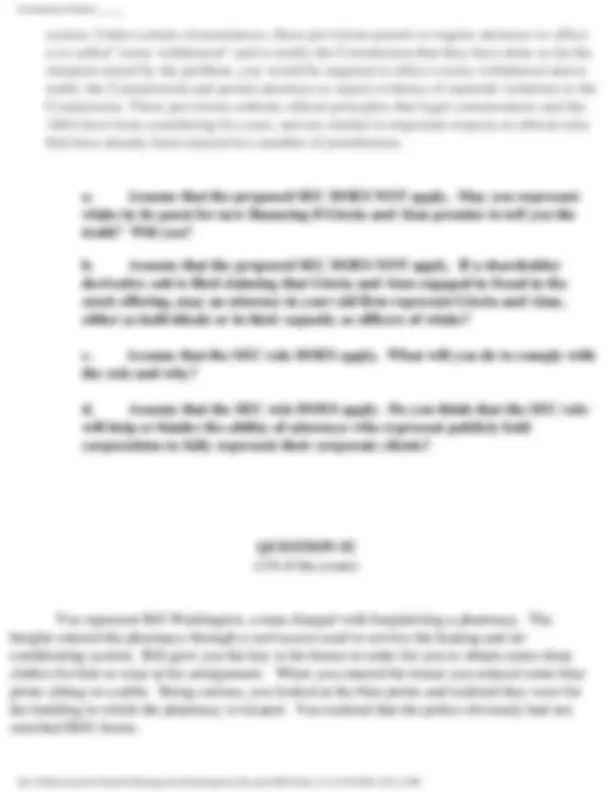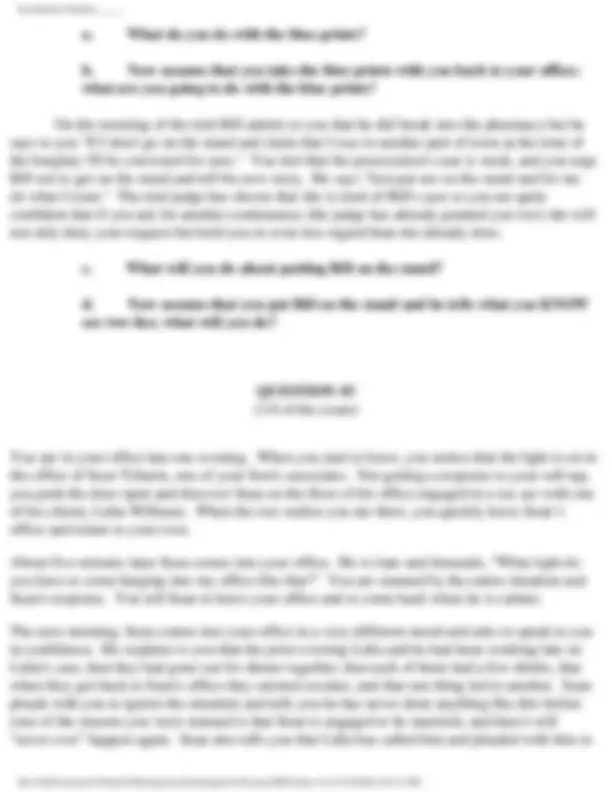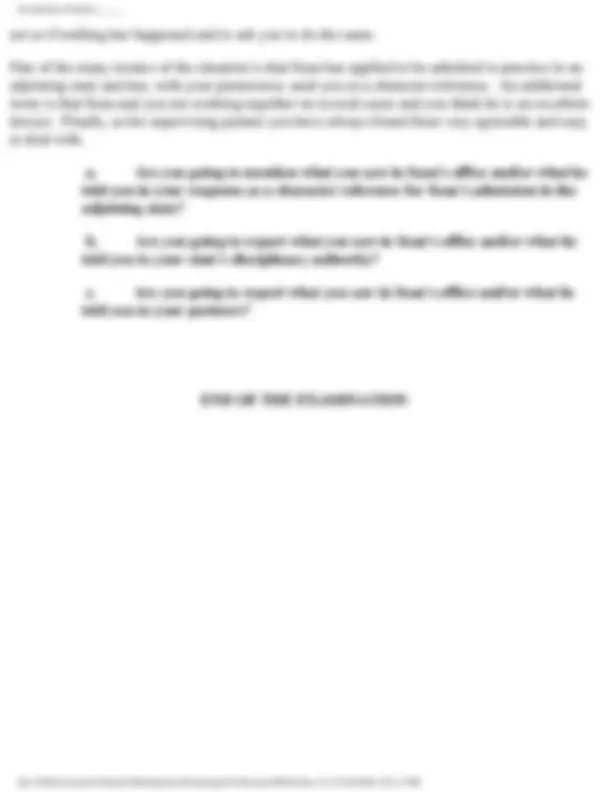





Study with the several resources on Docsity

Earn points by helping other students or get them with a premium plan


Prepare for your exams
Study with the several resources on Docsity

Earn points to download
Earn points by helping other students or get them with a premium plan
Community
Ask the community for help and clear up your study doubts
Discover the best universities in your country according to Docsity users
Free resources
Download our free guides on studying techniques, anxiety management strategies, and thesis advice from Docsity tutors
A law school examination focusing on professional responsibility. The students are required to answer questions related to representing a company that misrepresented its financial status during an initial public offering, and the ethical implications of such actions. The examination also includes scenarios involving client confidentiality and drug use by an associate. The students are expected to apply legal rules and ethical principles to the given situations.
Typology: Exams
1 / 5

This page cannot be seen from the preview
Don't miss anything!




Examination Number______
Professor J.G. Durham December 19, 2002 Section 02 9:00-11:00 a.m.
INSTRUCTIONS
(1/2 of the exam)
Your law firm represented wlake.com, an on-line auction company, which was founded 20 months ago by your clients, Gloria Pinchot and Alan Winston. Gloria is now the Chairman and CEO of wlake and Alan is the President and COO. One year ago you and other lawyers in your firm did the legal work for an initial public stock offering for wlake, and wlake paid your firm for this work. You and other lawyers in your firm prepared the offering materials from information Gloria and Alan gave you. You and your law firm were listed on the offering materials as the attorneys for wlake.
The prospectus you wrote stated that wlake was fully functioning. You reviewed reports by software, internet and marketing consultants, as well as reports by accountants and other professionals, that indicated that in fact wlake was a going concern. Finally, the prospectus stated that Gloria and Alan anticipated reaching profitability within 24 months.
Gloria and Alan recently made you a great offer to leave your firm and become wlake’s in- house General Counsel. When you arrived at wlake last month you quickly determined that Gloria and Alan had lied to you about wlake’s financial status and, in addition, that they had misrepresented the status of wlake during the public offering by altering many of the reports on which you relied. In fact wlake was not truly a going concern, but Gloria and Alan are working hard to get the business operating. The truth is that wlake is hemorrhaging money and has blown through almost all of the capital raised in the public stock offering. Gloria and Alan now want to raise more capital to keep wlake in business. They admit that they lied to you and that they altered the reports on which you relied. Nonetheless, they refuse to reveal what they have done in the past, they insist that they will be truthful in the future, and they plead with you to help them with the new financing.
As you consider your answer to the questions below, please also consider the following summary of part of the rule proposed by the SEC covering attorneys practicing before it (by representing wlake in its initial public offering and now being the General Counsel of a publicly held corporation, you are practicing before the SEC). The summary is from the explanation to the new rule prepared by the SEC, with footnotes omitted and the material in brackets [] added:
In addition to a rigorous "up the ladder" reporting requirement [similar to MR 1.13], the proposed rule incorporates several corollary provisions that are not explicitly required by Section 307 [of the Sarbanes-Oxley Act of 2002, 15 U.S.C. 7202 et. seq. ], but which the Commission believes are important components of an effective "up the ladder" reporting
a. What do you do with the blue prints?
b. Now assume that you take the blue prints with you back to your office; what are you going to do with the blue prints?
On the morning of the trial Bill admits to you that he did break into the pharmacy but he says to you "If I don't go on the stand and claim that I was in another part of town at the time of the burglary I'll be convicted for sure." You feel that the prosecution's case is weak, and you urge Bill not to get on the stand and tell his new story. He says "Just put me on the stand and let me do what I want." The trial judge has shown that she is tired of Bill's case so you are quite confident that if you ask for another continuance (the judge has already granted you two) she will not only deny your request but hold you in even less regard than she already does.
c. What will you do about putting Bill on the stand?
d. Now assume that you put Bill on the stand and he tells what you KNOW are two lies; what will you do?
(1/4 of the exam)
You are in your office late one evening. When you start to leave, you notice that the light is on in the office of Sean Tobarin, one of your firm's associates. Not getting a response to your soft tap, you push the door open and discover Sean on the floor of his office engaged in a sex act with one of his clients, Lidia Williams. When the two realize you are there, you quickly leave Sean’s office and return to your own.
About five minutes later Sean comes into your office. He is irate and demands, "What right do you have to come barging into my office like that?" You are stunned by the entire situation and Sean's response. You tell Sean to leave your office and to come back when he is calmer.
The next morning, Sean comes into your office in a very different mood and asks to speak to you in confidence. He explains to you that the prior evening Lidia and he had been working late on Lidia's case, that they had gone out for dinner together, that each of them had a few drinks, that when they got back to Sean's office they snorted cocaine, and that one thing led to another. Sean pleads with you to ignore the situation and tells you he has never done anything like this before (one of the reasons you were stunned is that Sean is engaged to be married), and that it will "never ever" happen again. Sean also tells you that Lidia has called him and pleaded with him to
act as if nothing has happened and to ask you to do the same.
One of the many ironies of the situation is that Sean has applied to be admitted to practice in an adjoining state and has, with your permission, used you as a character reference. An additional irony is that Sean and you are working together on several cases and you think he is an excellent lawyer. Finally, as his supervising partner you have always found Sean very agreeable and easy to deal with.
a. Are you going to mention what you saw in Sean's office and/or what he told you in your response as a character reference for Sean's admission in the adjoining state?
b. Are you going to report what you saw in Sean's office and/or what he told you to your state's disciplinary authority?
c. Are you going to report what you saw in Sean's office and/or what he told you to your partners?